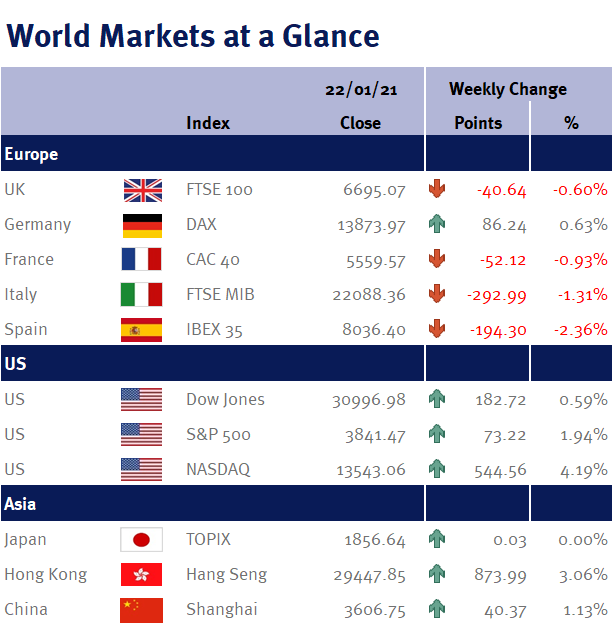The need for this new fiscal stimulus was laid bare in yesterday’s (Thursday 14 January 2021) weekly jobless claims data and today’s retail sales.
The jobless claims data provided clear evidence that the US employment market is starting to lose momentum given the recent stricter coronavirus lockdown restrictions, with initial claims for unemployment benefits climbing to 965,000 from 787,000 last week (the highest reading since mid-August). Continuing claims (which is a better indicator of ongoing US unemployment) were equally disappointing, with an increase of nearly 200,000 to 5.27m.
US retail sales also looked equally disappointing, falling 0.7% in December. Obviously with restaurants and high street stores closed, retail sales were likely to fall, however, the US ‘control group sales’ reading, which excludes areas such as food services, car dealerships and petrol stations (and in the current environment gives us a more accurate picture of underlying consumer demand), also fell by 1.9%, suggesting to us that the weakness can’t simply be blamed on lockdowns and that US consumers may be starting to tighten their belts – hence why Joe Biden’s $1.9tr stimulus proposal which includes $1,400 stimulus payments to eligible Americans and paid sick leave, is so important.
However, it wasn’t all doom and gloom. The Fed’s Beige Book showed in aggregate modest growth across the US; the Empire State survey showed that manufacturing continued to expand in January; and US industrial production rose by more than expected in December with an increase of 1.6%, while November’s reading was also revised up to 0.5%.
Additionally this week, despite all the market chatter regarding building inflationary pressures (which we have consistently dismissed in these commentaries), US CPI inflation again showed no signs of any pressures with a reading of 1.4% – and because we don’t see inflation going anywhere in the near term, we have consistently gone out on a limb to argue that the US central bank was unlikely to tighten monetary policy anytime soon, let alone increase US interest rates.
And thankfully during a speech yesterday, Jay Powell the Fed chair, confirmed this when he said “now is not the time to be talking about [tightening]” and that “when it does become appropriate”, the Fed will give the market plenty of notice.
Staying in the US, JPMorgan kicked-off the US quarterly reporting season with a record fourth-quarter profit of $12.1bn. This was not only 42% higher than this time last year, but absolutely trounced the forecasts made by Wall Street analysts, after it released $2.9bn of bad-loan provisions – as we said back in April (please see here), many US companies looked to us to be ‘kitchen sinking’ their results (when bad results was a given) in order to boost future profits. Therefore, JPMorgan could be the first of many companies to report better than expected profits.
In the UK, today’s GDP data for November showed that the economy contracted by 2.6%. While this may appear bad, this is actually a much better reading than we (and the major economists) expected given the lockdown restrictions (in fact, consensus estimates were for the economy to shrink by 4.6%) – and as such this bodes well for the Q4 GDP reading next month as a double dip recession may now be avoided.
Looking ahead to this coming week, it is a shorter US week due to the Martin Luther King Day on Monday (18 January 2021), while the obvious big event will be Joe Biden’s inauguration on Wednesday (20 January 2021). Data wise we have US, UK & Eurozone PMI data; US housing data; weekly US jobless claims; UK & Eurozone CPI inflation; UK & Chinese retail sales: Chinese Q4 GDP; Chinese industrial production; and an ECB monetary policy meeting.
Investment Management Team


